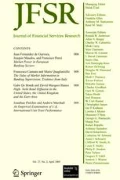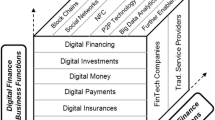Abstract
E-finance is defined as “The provision of financial services and markets using electronic communication and computation”. In this paper we outline research issues related to e-finance that we believe set the stage for further work in this field. Three areas are focused on. These are the use of electronic payments systems, the operations of financial services firms and the operation of financial markets. A number of research issues are raised. For example, is the widespread use of paper-based checks efficient? Will the financial services industry be fundamentally changed by the advent of the Internet? Why have there been such large differences in changes to market microstructure across different financial markets?
Similar content being viewed by others
References
Allen, F., and D. Gale. “Financial Markets, Intermediaries, and Intertemporal Smoothing.” Journal of Political Economy 105 (1997), 523–546.
Allen, H., J. Hawkins, and S. Sato. “Electronic Trading and its Implications for Financial Systems.” Working paper, Bank of England, 2001.
Bank for International Settlements. Statistics on Payment Systems in the Group of Ten Countries. Basel: Switzerland, 2000.
Banks, Erik. E-Finance: The Electronic Revolution. London: John Wiley & Sons, 2001.
Baxter, William F. “Bank Interchange of Transactional Paper: Legal and Economic Perspectives.” Journal of Law & Economics 24 (1983), October, 541–588.
Berger, Allen N., Rebecca S. Demsetz, and Philip E. Strahan. “The Consolidation of the Financial Services Industry: Cause, Consequences and Implications for the Future.” Journal of Banking and Finance 23 (1999), 135–194.
Berger, Allen N., and Gregory F. Udell. “Some Evidence on the Empirical Significance of Credit Rationing,” Journal of Political Economy (1992), 1047–1081.
Berger, Allen N., and Gregory F. Udell. “Relationship Lending and Lines of Credit in Small Firm Finance,” Journal of Business 68 (1995), 351–382.
Berger, Allen N., and Gregory F. Udell. “The Economics of Small Business Finance: The Roles of Private Equity and Debt Markets in the Financial Growth Cycle.” Journal of Banking and Finance 22 (1998), 613–673.
Berger, Allen N., Anthony A. Saunders, Joseph K. Scalise, and Gregory F. Udell. “The Effects of Bank Mergers and Acquisitions on Small Business Lending.” Journal of Financial Economics 50 (1998).
Bernanke, Ben, and Alan Blinder. “The Federal Funds Rate and the Channels of Monetary Policy.” American Economic Review 82,no. 4 (1992), 901–921.
Bonacorrsi di Patti, Emilia, and Giovanni Dell'ariccia. “Bank Competition and Firm Creation.” Mimeo, January 30, 2000.
Boot, Arnoud, and Anjan V. Thakor. “Can Relationship Banking Survive Competition?” Journal of Finance 55,no. 2 (2000), 679–714.
Black, Sandra E., and Philip E. Strahan. “Entrepreneurship and Bank Credit Availability.” Journal of Finance (forthcoming).
Carlton, Dennis W., and Alan S. Frankel. “The Antitrust Economics of Credit Card Networks.” Antitrust Law Journal 63,no. 2, Winter (1995), 643–668.
Chakravorti, Sujit, and Ted To. “A Theory of Merchant Credit Card Acceptance.” Federal Reserve Bank of Chicago Working Paper Series, WP–99–16, November, 1999.
Cetorelli, Nicola, and Michele Gambera. “Bank Structure, Financial Dependence and Growth: Intenational Evidence from Industrial Data.” Journal of Finance (forthcoming).
Cole, Rebel A. “The Importance of Relationships to the Availability of Credit.” Journal of Banking and Finance 22 (1998), 959–977.
Cole, Rebel A., Lawrence G. Goldberg, and Lawrence J. White. “Cookie-Cutter versus Character: The Micro Structure of Small Business Lending by Large and Small Banks.” Proceedings of Conference on Business Access to Capital and Credit, March 8–9, 1999.
Craig, Ben R., and Joao A.C. dos Santos. “Banking Consolidation: Impact on Small Business Lending.” Working paper, Federal Reserve Bank of Cleveland, 1997.
Cyrnak, A., Hannan, Timothy H. “Bank Lending to Small Businesses and the Use of CRA Loan Data to Measure Market Structure.” Federal Reserve Board working paper, 1998.
Danthine, Jean-Pierre, Francesco Giavazzi, Xavier Vives, and Ernst-Ludwig von Thadden. The Future of European Banking, CEPR monograph on European Integration 9, 1999.
Diamond, Douglas. “Financial Intermediation and Delegated Monitoring.” Review of Economic Studies 51 (1984), 393–414.
Domowitz, Ian, and Benn Steil. “Automation, Trading Costs, and the Structure of the Securities Trading Industry.” Brookings-Wharton Papers on Financial Services 2 (1999), 33–92.
Estrella, Arturo. “Securitization and the Efficacy of Monetary Policy.” Presented at the Federal Reserve Bank of New York Conference on Financial Innovation and Monetary Transmission, July 2001.
Evans, David S., and Richard Schmalensee. Paying with Plastic: The Digital Revolution and Borrowing. MIT Press, 1999.
Fabozzi, F. J. The Handbook of Fixed Income Securities. New York: McGraw-Hill, 2001.
Federal Reserve Board of Governors. 2000. Report to Congress on Markets for Small Business and Commercial Mortgage Related Securities Markets, available online at http://www.federalreserve.gov/boarddocs/RptCongress/markets2000.pdf.
General Accounting Office, Payments, Clearance, and Settlement: A Guide to the System, Risks and Issues, June, 1997.
Gertler, Mark, and Simon Gilchrist. “Monetary Policy, Business Cycles and the Behavior of Small Manufacturing Firms.” Quarterly Journal of Economics (1994), 309–340.
Gilbert, R. Alton. “The Advent of the Federal Reserve and the Efficiency of the Payments System: The Collection of Checks, 195–1930.” Explorations in Economic History 37 (April, 2000), 121–148.
Hancock, Diana, David B. Humphrey, and James A. Wilcox. “Cost Reductions in Electronic Payments: The Roles of Consolidation, Economies of Scale and Technical Change.” Journal of Banking and Finance 23 (1999), 391–421.
Hannan, Timothy H. “Market Share Inequality, the Number of Competitors, and the HHI: An Examination of Bank Pricing.” Review of Industrial Organization 12 (1997), 23–35.
Huck, Paul, Sherrie L. W. Rhine, Philip Bond, and Robert P. Townsend. “A Comparison of Small Business Finance in Two Chicago Minority Neighborhoods.” Proceedings of Conference on Business Access to Capital and Credit, March 8–9, 1999.
Humphrey, David B., Setsuya Sato, Masayoshi Tsurumi, and Jukka M. Vesala. “The Evolution of Payments in Europe, Japan, and the US: Lessons for Emerging Market Economies.” World Bank Policy Research Working Paper, 1676, October, 1996.
Humphrey, David B., L. Pulley, and Jukka M. Vesala. “Cash, Paper and Electronic Payments: A Cross-Country Analysis.” Journal of Money, Credit and Banking 28,no. 4 (1996), 914–939.
Humphrey, David B., L. Pulley, and Jukka M. Vesala. “The Check's in the Mail: why the US Lags Behind in the Adoption of Cost Saving Electronic Payments.” Journal of Financial Services Research 17,no. 1 (2000), 17–39.
Jayaratne, Jith, and Philip E. Strahan. “Entry Restrictions, Industry Evolution and Dynamic Efficiency: Evidence from Commercial Banking.” Journal of Law and Economics 41 (1998), 239–274.
Jayaratne, Jith, and John D. Wolken. “How Important are Small Banks to Small Business Lending? New Evidence from a Survey of Small Businesses.” Journal of Banking and Finance 23 (1999), 427–458.
Keeton, William R. “Do Bank Mergers Reduce Lending to Businesses and Farmers? New Evidence from Tenth District States.” Federal Reserve Bank of Kansas City, Economic Review 81,no. 3 (1996), 63–75.
Keeton, William R. “The Effects of Mergers on Farm and Business Lending at Small Banks: New Evidence from Tenth District States.” Working paper, Federal Reserve Bank of Kansas City, 1997.
Kolari, J., and A. Zardkoohi. “The Impact of Structural Change in the Banking Industry on Small Business Lending.” Report to the Small Business Administration, 1997a.
Kolari, J., and A. Zardkoohi, A. “Bank Acquisitions and Small Business Lending.” Working paper, Texas A&M University, 1997b.
Loughran, T., J. Ritter, and K. Rydqvist. “Initial Public Offerings: International Insights.” Pacific-Basin Finance Journal 2 (1994), 165–199.
Lown, Cara, and Donald P. Morgan. “Credit Effects in Monetary Policy, Then and Now.” Presented at the Federal Reserve Bank of New York Conference on Financial Innovation and Monetary Transmission, March 30, 2001.
Lyons, R. K. The Microstructure Approach to Exchange Rates. Cambridge, A: MIT Press (forthcoming).
Madhavan, Ananth. “In Search of Liquidity in the Internet Era.” paper presented at the Ninth Annual Financial Markets Conference of the Federal Reserve Bank of Atlanta 2000.
Marquez, Robert. “Competition, Adverse Selection and Information Dispersion in the Banking Industry.” Review of Financial Studies (forthcoming).
Mester, Loretta J. “The Changing Nature of the Payments System: Should New Players Mean New Rules?” Business Review, Federal Reserve Bank of Philadelphia, March/April: 3–26, 2000.
McAndrews, James, and William Roberds. “A General Equilibrium Analysis of Check Float.” Journal of Financial Intermediation 8 October (1999), 353–377.
McAndrews, James, and William Roberds. “The Economics of Check Float.” Economic Review, Federal Reserve Bank of Atlanta, Fourth Quarter, 1999, 1–11.
McAndrews, James, and Chris Stefanadis. “The Emergence of Electronic Communications Networks in the US Equity Markets.” Current Issues in Economics and Finance, Federal Reserve Bank of New York 6,no. 12 (2000).
McAndrews, James, and Chris Stefanadis. “The Development of Pan-European Stock Exchanges.” Mimeo, Federal Reserve Bank of New York, September 2001.
Mishkin, Frederic S., and Philip E. Strahan. “What Will Technology do to the Financial Structure?” In: The Effect of Technology on the Financial Sector, Brookings-Wharton Papers on Financial Services, Robert Litan and Anthony Santomero, eds, 1999, 249–287.
O'Hara, M. Market Microstructure Theory. Cambridge, MA: Blackwell, 1995.
Peek, Joe, and Eric S. Rosengren. “Small Business Credit Availability: How Important is the Size of the Lender?” In: A. Saunders, and I. Walter, eds, Financial System Design: The Case for Universal Banking. Burr Ridge, IL: Irwin Publishing, 1996, 628–655.
Peek, Joe, and Eric S. Rosengren. “Bank Consolidation and Small Business Lending: It's not Just Bank Size that Matters.” Journal of Banking and Finance 22 (1998).
Petersen, Mitchell A., and Raghuram G. Rajan. “The Benefits of Firm-Creditor Relationships: Evidence from Small Business Data.” Journal of Finance 49 (1994), 3–37.
Petersen, Mitchell A., and Raghuram G. Rajan. “The Effect of Credit Market Competition on Lending Relationships.” Quarterly Journal of Economics 110 (1995), 407–443.
Petersen, Mitchell A., and Raghuram G. Rajan. “Does Distance Still Matter? The Information Revolution in Small Business Lending.” Mimeo, March, 2001.
Radecki, Lawrence J. “The Expanding Geographic Reach of Retail Banking Markets.” Federal Reserve Bank of New York Economic Policy Review 4 (1998), 15–34.
Radecki, Lawrence J., John Wenninger, and Daniel K. Orlow. “Industry Structure: Electronic Delivery's Potential Effects on Retail Banking.” Journal of Retail Banking Services 19,no. 4 (1997), 57–63.
Rochet, Jean-Charles, and Jean Tirole. “Cooperation among Competitors: The Economics of Payment Card Associations.” Mimeo, Institut D'Economie Industrielle, University of Toulouse, 2000.
Sapienza, Paola. “The Effects of Banking Mergers on Loan Contracts.” Northwestern University working paper, 1998.
Schmalensee, R. “Payment Systems and Interchange Fees.” Unpublished manuscript, Massachusetts Institute of Technology, December 2000.
Securities Industry Association. Securities Industry Fact Book, available online at http://www.sia.com/publications/html/fact_book.html, 2000.
Sofianos, George. “Comments.” Financial Market 2000 Conference on E-Finance, Federal Reserve Bank of Atlanta, October 2000.
Strahan, Philip E., and James P. Weston. “Small Business Lending and the Changing Structure of the Banking Industry.” Journal of Banking and Finance 22 (1998), 821–845.
Thompson Financial. “EFT Data Book.” ATM & Debit News, 1,no. 44 (September 13, 2001).
United States Senate Committee on Banking, Housing and Urban Affairs. The Financial Marketplace of the Future: Hearings. 106th Congress, 2nd session, February 29, 2000.
Wells, Kirsten E. “Are Checks Overused?” Quarterly Review, Federal Reserve Bank of Minneapolis, 20 (1996), Fall: 2–12.
Wilhelm, William J. “Internet Investment Banking: The Effect of Information Technology on Relationship Banking.” Journal of Applied Corporate Finance Spring (1999).
Zardkoohi, A., and J. Kolari. “The Effect of Structural Changes in the US Banking Industry on Small Business Lending.” Working paper, Texas A&M University, 1997.




